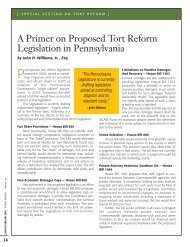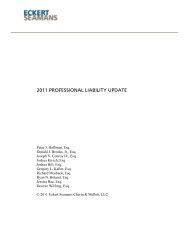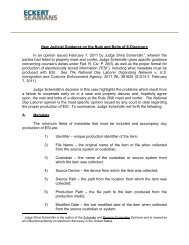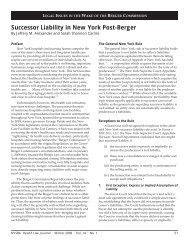is a failure to report changes in a patient’s condition and/or toquestion a physician’s orders which is not in accord with standardmedical practice and the patient is injured as a result, the hospitalwill be liable for such negligence.Id. at n.13.The Welsh court did not require a showing of “systemic” negligence by the hospitalDefendant in order to establish corporate liability.In Krapf v. St. Luke’s Hospital, 4. A.3d 642 (Pa. Super 2010), the plaintiffs, on behalf ofthe estates of five (5) decedents, filed wrongful death and survival actions against the defendanthospital. By way of background, a critical care unit (“CCU”) nurse employed by the defendanthospital raised suspicion of harming patients by administering various intravenous medicationswithout authorization. Id. at 645. A nursing manager initially investigated the situation afterused and unused medications were found in a trash receptacle. Id. The hospital’s attorneyinvestigated. Id. During his investigation, employees raised concern about Nurse Cullen, but theattorney completed his investigation without interviewing Nurse Cullen or identifying the culprit.Id. Additional used and unused medications were found two (2) days later in another location.Id. The hospital’s risk manager informed the attorney and advised him that Nurse Cullen may beto blame. Id. The attorney confronted Nurse Cullen and, despite denying the allegations, NurseCullen resigned. Id. at 645-646. The hospital’s attorney investigated into whether any patientswere harmed by the improperly administered medications and, based upon his investigation,apparently was confident that no patients were harmed. Id. at 646. Despite the attorney’sfindings, various nurses raised concerns about an unusually high number of patient deaths duringNurse Cullen’s shift to the attorney, as well as the hospital’s Clinical Care Coordinator and theCCU Nursing Manager. Id. at 646-647. Their concerns apparently were met with resistance andultimately ignored. Id. at 647.Approximately a year and a half later, Nurse Cullen was fired when his new employerhad suspicion of inappropriate patient care. Id. In response to questioning by police, NurseCullen confessed to killing a number of patients, including the plaintiffs’ decedents. Id. Theplaintiffs subsequently filed suit against the hospital, alleging inter alia, corporate negligence.The hospital moved for summary judgment arguing that the plaintiffs’ claims were barred by thestatute of limitations. Id. at 648. The motion was denied. Id. The hospital appealed. Id.In affirming the denial of summary judgment, the Superior Court addressed thesufficiency of the plaintiffs’ corporate negligence claims. The Superior Court noted that[c]orporate negligence is a doctrine under which the hospital is liable if itfails to uphold the proper standard of care owed the patient, which is toensure the patient’s safety and well-being while at the hospital. Thistheory of liability creates a nondelegable duty which the hospital owesdirectly to the patient. Therefore, an injured party does not have to rely onand establish the negligence of a third party.64
The hospital’s duties have been classified into four general areas: (1) aduty to use reasonable care in the maintenance of safe and adequatefacilities and equipment; (2) a duty to select and retain only competentphysicians; (3) a duty to oversee all persons who practice medicine withinits walls as to patient care; and (4) a duty to formulate, adopt and enforceadequate rules and policies to ensure quality care for the patients.Id. at 651 (citing Thompson v. Nason Hosp., 527 Pa. 330, 591 A.2d 703 (Pa. 1991)). Inexplaining the hospital’s duties, the court stated that hospital staff and employees have “[a] dutyto recognize and report abnormalities in the treatment and condition of [their] patients.” Id.(citing Thompson, supra). A hospital may be held liable for a breach of the Thompson dutieswhere it has constructive notice – “should have known” – but fails to act. Id. at 653. Moreover,[c]onstructive notice must be imposed when the failure to receive actualnotice is caused by the absence of supervision. We interpret “failure toenforce adequate rules and policies” as an analog to “failure to provideadequate supervision.”Id. The court concluded that the facts of record, specifically the testimony of the nurse whoclaimed that their concerns went ignored by hospital supervisors charged with investigating thesituation, support the application of constructive notice. Id.In Davis v. Frederick, 2010 WL 3566833 (E.D. Pa. Sept. 9, 2010), the plaintiffs filed amedical malpractice action against the physician and hospital arising out of allegedly negligenttreatment of the plaintiff’s decedent. The plaintiffs set forth, intra alia, claims of corporateliability against the hospital defendant. Id. at *1. The defendant hospital filed a Motion toDismiss pursuant to Federal Rule of Civil Procedure 12(b)(6). Id. In its motion, the defendantargued that the plaintiffs failed to plead sufficient facts to support a claim of corporatenegligence. Id. at *2. In addressing the defendant’s motion, the district court noted that “[u]nderPennsylvania law, corporate negligence is a basis for hospital liability separate from the liabilityof the practitioners who actually have rendered medical care to a patient.” Id. (internal citationsand quotations omitted). The court noted the four (4) discrete areas of a hospital’s generalcorporate duties as first recognized in Thompson. Id. Upon examining the plaintiffs’ Complaint,the court found that the claim for corporate negligence was properly pled. Id. The courtexplained that the Complaint alleged that the hospital defendant[failed] to insure that physician personnel and resident physicianspracticing at [the defendant hospital] and participating in [the plaintiff’s]treatment and care were appropriately knowledgeable, experienced, andtrained in the management, diagnosis, treatment, treatment options andindications for gall bladder surgical intervention and complications fromthese medical conditions; [failed] to implement adequate policies andprocedures for discharge and follow-up of patients having outpatientabdominal surgery; and [failed] to formulate, adopt and enforce policiesand procedures for adequate evaluations in the post-operative recovery65
- Page 3 and 4:
EMTALA CASES ......................
- Page 5:
Filing an Affidavit of Non-Involvem
- Page 8 and 9:
II.PROFESSIONAL LIABILITY - AN OVER
- Page 10 and 11:
The Superior Court reversed the tri
- Page 12 and 13:
to a third party pursuant to the st
- Page 14 and 15:
After approximately five months, De
- Page 16 and 17:
learned the day after the surgery t
- Page 18 and 19:
conduct to the delay in colon cance
- Page 20 and 21: court admitted the expert’s testi
- Page 22 and 23: (b)(c)other reasonable causes, incl
- Page 24 and 25: corroborated his testimony. The cou
- Page 26 and 27: husband’s estate. Plaintiff alleg
- Page 28 and 29: Other notable federal cases arising
- Page 30 and 31: The Superior Court found that in re
- Page 32 and 33: § 1303.512(b). The court, however,
- Page 34 and 35: In Neidig v. United States, No. 07-
- Page 36 and 37: Additionally, the Supreme Court not
- Page 38 and 39: were not indicated for her conditio
- Page 40 and 41: surgeon is the same as it would be
- Page 42 and 43: It should be noted that the Superio
- Page 44 and 45: Finally, the court held that the tr
- Page 46 and 47: The Supreme Court of Pennsylvania r
- Page 48 and 49: nurses deviating from applicable st
- Page 50 and 51: certainty, the court reviews expert
- Page 52 and 53: Under Pennsylvania law, the Court n
- Page 54 and 55: testimony, Defendant presented his
- Page 56 and 57: Following Cooper v. Roberts, 286 A.
- Page 58 and 59: Plaintiff developed chronic diarrhe
- Page 60 and 61: where payment is made by Medicaid w
- Page 62 and 63: accomplished. In Valles v. Albert E
- Page 64 and 65: In 1980, the Pennsylvania Superior
- Page 66 and 67: Plaintiff had a routine monitoring
- Page 68 and 69: Plaintiff’s Contract ClaimsThe Co
- Page 72 and 73: unit to assure post-surgical patien
- Page 74 and 75: sliced his wrist and arm with a raz
- Page 76 and 77: licensed professionals for whom the
- Page 78 and 79: (c)Limitations of Corporate Neglige
- Page 80 and 81: Even more recently, our Superior Co
- Page 82 and 83: (a)HMO IssuesIn McClellan v. Health
- Page 84 and 85: affidavit submitted by Defendants o
- Page 86 and 87: treatments while at VA’s faciliti
- Page 88 and 89: [s]ubstantively, we believe that a
- Page 90 and 91: The party claiming the benefit of t
- Page 92 and 93: deprive (him) of civil rights guara
- Page 94 and 95: found that the District Court was w
- Page 96 and 97: With respect to fraudulent concealm
- Page 98 and 99: would be applied in situations wher
- Page 100 and 101: they had not raised them in the cou
- Page 102 and 103: (a)Informed ConsentUnder MCARE, a p
- Page 104 and 105: civil enforcement provisions and ma
- Page 106 and 107: MCARE also changes the manner in wh
- Page 108 and 109: whose death, in 2005, was allegedly
- Page 110 and 111: vicariously liable if the plaintiff
- Page 112 and 113: health center or its equivalent or
- Page 114 and 115: In Pennsylvania Medical Society, th
- Page 116 and 117: to any professional who is alleged
- Page 118 and 119: Since the 2005 amendments, there ha
- Page 120 and 121:
ule, but who intentionally ignores
- Page 122 and 123:
the original Complaint was delivere
- Page 124 and 125:
foreclose all challenges against th
- Page 126 and 127:
number of boxes), which was support
- Page 128 and 129:
questions of professional judgment
- Page 130 and 131:
deviated from any professional stan
- Page 132 and 133:
The Third Circuit affirmed the Dist
- Page 134 and 135:
claims and cross-claims remain agai
- Page 136 and 137:
By an Amendatory Order dated March
- Page 138 and 139:
The court acknowledged that there i
- Page 140 and 141:
apply and that the trial court misa
- Page 142 and 143:
Barbados had enough litigation-spec
- Page 144 and 145:
E. Preemption of Vaccine Design Def
- Page 146 and 147:
2. Pa. R. Civ. Pro. 1036.1 - Reinst
- Page 148 and 149:
Barrick, at *34-35.Furthermore, the
- Page 150 and 151:
(b) the utility of the defendant’
- Page 152 and 153:
2006). In this case, Plaintiffs bro
- Page 154 and 155:
B. Elements of a Cause of Action fo
- Page 156 and 157:
decision in Muhammad precluded Mr.
- Page 158 and 159:
considered speculative “only if t
- Page 160 and 161:
underlying cause of action involved
- Page 162 and 163:
In Capital Care Corp., the Superior
- Page 164 and 165:
The court found, however, to state
- Page 166 and 167:
of reasonable diligence. The standa
- Page 168 and 169:
not be set aside. On July 7, 2005,
- Page 170 and 171:
complete bar to recovery. Since a l
- Page 172 and 173:
On appeal, Plaintiffs claimed that
- Page 174 and 175:
In Liggon-Redding, 659 F.3d at 265,
- Page 176 and 177:
elieved of those minimum standards
- Page 178 and 179:
elevant to the proceedings, the com
- Page 180 and 181:
establish professional misconduct b
- Page 182 and 183:
Upholding the Superior Court’s Or
- Page 184 and 185:
Id.Rejecting revocation and suspens
- Page 186 and 187:
order as a sanction under Rule 4019
- Page 188:
{1009912]182









